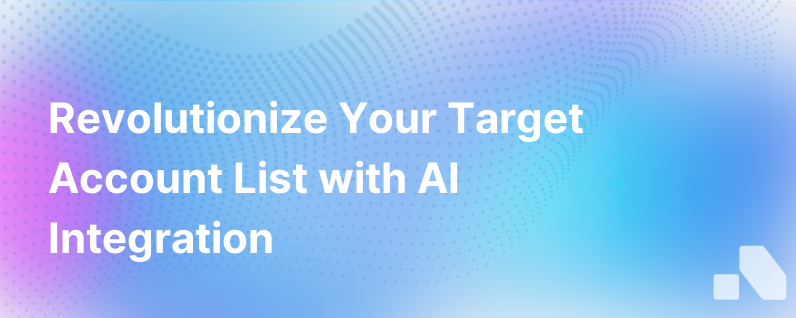Talking About Tal Why Your Target Account List Needs Ai
Published on October 14, 2023 by David Zhang
In the rapidly evolving landscape of B2B sales, the ability to narrow down and effectively target the right accounts can be the difference between a sales team that struggles and one that thrives. Target Account Lists (TALs) have long been a staple of strategic sales initiatives, enabling sales and marketing teams to focus their efforts on the accounts most likely to convert, grow, and provide long-term value.
But, as the complexity of sales processes and the volume of available data grow, manually curating and maintaining a TAL is becoming increasingly challenging and time-consuming. This is where Artificial Intelligence (AI) comes into play, transforming TALs from static lists into dynamic, intelligent engines that drive efficiency and effectiveness in sales outreach.
Understanding the Limitations of Traditional Target Account Lists
Before diving into the role of AI, it's important to acknowledge the shortcomings of traditional TALs. Typically, sales teams would select target accounts based on a combination of historical data, firmographic criteria, and intuition. While this methodology has merits, it's often wrought with human biases and lacks the ability to scale and adapt as market conditions change. Such lists are static, missing out on real-time data signals that could indicate a prospect’s readiness to buy or a shift in strategic focus.
The Emergence of AI in Account Selection
AI is revolutionizing the way sales teams approach their TALs by introducing sophisticated algorithms that process vast sets of data to uncover insights that humans simply can't detect at scale. Here’s why an AI-powered TAL isn't just a nice-to-have but a strategic necessity for sales organizations aiming to stay competitive:
1. Enhanced Data Analysis
Sales and marketing data is expansive and complex. It includes structured data such as industry, company size, and revenue, but also unstructured data like news articles, social media activity, and job postings. AI is adept at analyzing these diverse datasets rapidly, recognizing patterns, and identifying which accounts have the highest propensity to buy.
2. Predictive Insights
Leveraging Machine Learning (ML), AI can predict which accounts are most likely to convert by analyzing historical conversion data and identifying similar traits among prospects. AI applications can also forecast customer churn, helping retain high-value clients and mitigate potential revenue loss.
3. Dynamic List Adaptation
Market conditions are constantly changing, and an account that might not have been a high priority last quarter might suddenly become a hot prospect. AI-powered tools continuously ingest new data, allowing your TAL to evolve in almost real-time, so sales efforts aren't wasted on low-potential accounts.
4. Personalization at Scale
Personalization has become a key differentiator in sales strategies. AI excels at segmenting accounts into micro-categories based on specific behaviors or needs. This allows sales teams to tailor their outreach, vastly improving engagement and conversion rates.
5. Time and Resource Optimization
Frees up valuable sales and marketing resources by reducing the time needed for research and data analysis. Sales representatives can focus more on selling and less on sifting through data, increasing productivity and morale.
Case Studies and Practical Applications
Real-world applications of AI-powered TAL management systems have already started to make an impact across industries. For instance, a leading tech company applied AI to their account selection process and saw a 25% increase in sales to target accounts within the first year. The system was able to identify signals that their sales team previously couldn’t ascertain, such as changes in leadership within an account, which oftentimes indicate a new direction and potential need for their services.
Similarly, a financial services firm using AI predictive analytics for their TAL reported a 38% lift in their win rates due to more precise targeting and timing of their outreach efforts based on AI insights into the prospect's buy cycle and pain points.
Implementing AI in Your TAL Strategy
For businesses considering integrating AI into their TAL strategies, it's essential to understand that the success of such an endeavor depends on the quality of the data feeding the algorithms and the sales team's willingness to embrace and act on AI-driven insights.
- Data Hygiene: Ensure your CRM and other data sources are clean and well-maintained. AI models are only as good as the data they're based on.
- Clear Objectives: Understand what you want to achieve with AI. Is it prioritizing accounts, predicting churn, or identifying upsell opportunities?
- Sales Enablement: Equip your sales team with the tools and training they need to understand and utilize AI-driven insights effectively.
- Continuous Learning: Use feedback loops to refine your AI models. Over time, they'll become more accurate and provide even greater value.
Conclusion
As we enter a new era of data-driven sales, AI is not just enhancing Target Account Lists — it's redefining them. By embracing AI, sales organizations can move beyond the limitations of traditional TALs, harnessing the power of predictive analytics and personalization to target the right accounts with the right message at the right time. This strategic pivot is not a futuristic luxury but a present-day imperative for those looking to outpace their competitors and capitalize on the untapped potential within their markets.
Platforms like Aomni provide an excellent starting point for integrating AI into your TAL strategy. These systems are designed to give you the actionable insights and real-time account intelligence you need to stay a step ahead, ensuring that every sales action is informed, strategic, and primed for success.